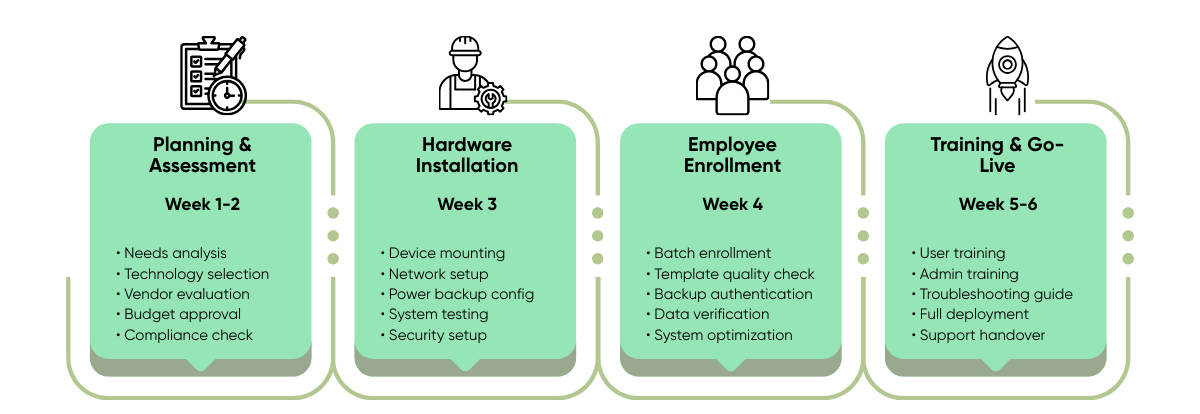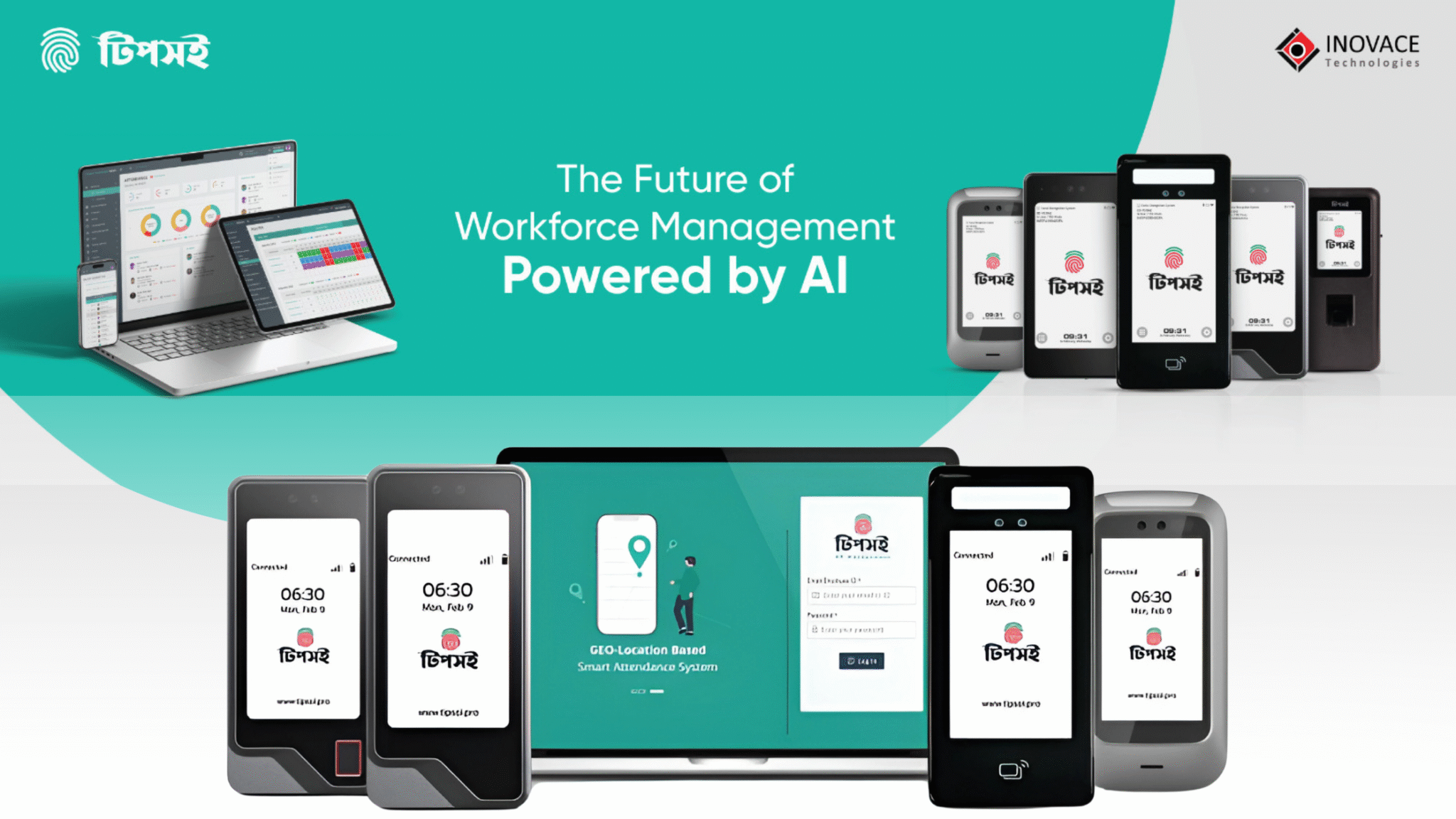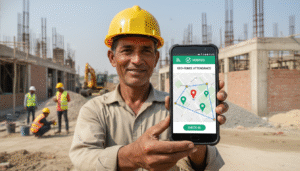In 2025, manual attendance tracking costs Bangladeshi businesses up to 2.2% of their annual payroll, that’s ৳220,000 lost per ৳1 crore in wages. With 75% of companies experiencing buddy punching according to American Payroll Association research, a biometric attendance system eliminates these losses by using unique biological characteristics to verify employee identity with 99.9% accuracy.
What is biometric attendance system technology becomes crucial as Bangladeshi organizations seek reliable workforce management solutions. From Dhaka’s corporate offices to Chittagong’s manufacturing plants, businesses are adopting biometric time tracking to combat time theft and streamline operations.
This comprehensive guide covers biometric attendance system fundamentals, Bangladesh-specific implementation strategies, local cost analysis, and vendor selection criteria to help organizations make informed decisions.
Industry data confirms that companies implementing biometric time tracking achieve significant cost savings, with 92% of accountants reporting clients paying 5% higher labor costs due to time theft (Accu-Time Systems).

Credit: getsafeandsound.com
Understanding Biometric Attendance Systems
Biometric Attendance Systems
A biometric attendance system is an automated workforce management solution that uses unique biological characteristics (fingerprints, face, iris) to identify employees for time tracking, achieving 99.9% accuracy while eliminating buddy punching and time theft completely.
Basic Definition
A biometric attendance system is an automated workforce management solution that uses unique biological characteristics to identify and verify employee identity for time tracking purposes. These digital attendance systems capture, store, and match biological data points such as fingerprints, facial features, iris patterns, or voice recognition to ensure accurate attendance recording.
Unlike traditional punch cards or PIN-based systems, biometric authentication technology creates an unbreakable link between the employee and their attendance record. The attendance management system functions by comparing live biometric data against pre-enrolled templates stored in a secure database.
Research from the National Institute of Standards and Technology (NIST) indicates that biometric identification offers superior accuracy compared to conventional methods. Modern fingerprint systems achieve 99.9% accuracy rates for four-finger tests, while facial recognition systems reach high precision under optimal conditions (Bayometric).
How It Works (Simple Explanation)
The biometric attendance system operates through two distinct phases: enrollment and authentication.
Enrollment Process: During initial setup, employees provide their biometric samples multiple times to create comprehensive templates. The system captures raw biometric data, extracts unique features, and converts them into encrypted mathematical representations stored in the database.
Authentication Process: When employees clock in or out, they present their biometric sample to the scanner. The system captures the live sample, extracts features, and compares them against stored templates using sophisticated matching algorithms. Successful matches trigger attendance recording with timestamp data.
Data Management: The system maintains detailed logs of all attendance events, storing employee ID, timestamp, location, and verification confidence scores. Modern biometric attendance systems process verification in under 2 seconds while maintaining comprehensive audit trails.
Key Components
Biometric attendance systems comprise three essential elements working in coordination:
Hardware Components: Biometric scanners and readers serve as data capture devices. Fingerprint scanners use optical or capacitive sensors, while facial recognition systems employ high-resolution cameras with infrared capabilities. Advanced systems include liveness detection to prevent spoofing attempts.
Software Platform: The time and attendance software handles enrollment, template creation, matching algorithms, and attendance reporting. Cloud-based platforms offer remote access and real-time synchronization across multiple locations, while on-premise employee attendance systems provide enhanced data control.
Database Infrastructure: Secure databases store encrypted biometric templates, employee information, and attendance records. Modern systems use AES-256 encryption and comply with international data protection standards including GDPR and Bangladesh’s Digital Security Act 2018.
Key Takeaway: Biometric attendance systems combine advanced hardware, intelligent software, and secure databases to create tamper-proof employee time tracking solutions with 99.9% accuracy rates, saving Bangladeshi businesses an average of ৳2-8 lakh annually per 100 employees.
How Does a Biometric Attendance System Work?
The system captures a person’s unique feature. It stores this feature in a database. When a person checks in, the system compares the feature. If it matches, the system records attendance.
Here is a step-by-step process:
- The person places their finger on a scanner.
- The scanner reads the fingerprint.
- The system compares the fingerprint with the database.
- If there is a match, the system records the time.
Types of Biometric Technology Used in Bangladesh
1. Fingerprint Recognition
Fingerprint attendance systems represent the most widely deployed biometric technology in Bangladesh, capturing unique ridge patterns and minutiae points for identification. These solutions use optical, capacitive, or ultrasonic sensors to create detailed fingerprint images processed by sophisticated algorithms.
Technology Accuracy: Industry studies confirm fingerprint attendance systems achieve 99.9% accuracy with False Acceptance Rates (FAR) below 0.01% and False Rejection Rates (FRR) under 1%. Advanced devices process verification in 0.5-2 seconds with template sizes of 256-1024 bytes.
Advantages for Bangladesh Market:
- Lowest implementation cost (৳8,000-15,000 per device)
- High user acceptance due to familiarity
- Compact hardware suitable for space-constrained offices
- Proven technology with decades of development
- Works effectively in air-conditioned environments
Limitations in Local Context:
- May struggle during monsoon season (5-10% accuracy drop)
- Affected by cuts, burns from industrial work
- Requires regular cleaning in dusty environments
- Single-point verification offers moderate security level
Best Use Cases: Fingerprint attendance systems excel in Dhaka’s corporate offices, Chittagong’s port facilities, and small-to-medium businesses requiring cost-effective employee time tracking with reliable accuracy.
2. Face Recognition
Face recognition attendance technology analyzes unique facial features, bone structure, and geometric relationships to verify employee identity. Modern systems use 3D mapping and infrared sensors to prevent photo-based spoofing while accommodating natural appearance changes.
Performance in Bangladesh: Current facial recognition systems achieve 99.7% accuracy under controlled lighting conditions, with verification speeds of 1-3 seconds. Advanced algorithms identify individuals even with glasses, traditional headwear, or minor weight fluctuations, important for Bangladesh’s diverse workforce.
Advantages:
- Contactless operation enhances hygiene (post-COVID preference)
- Simultaneous multiple user verification for shift changes
- Works at distance up to 2-3 meters
- Accommodates cultural dress variations
- Integration with existing security camera systems
Privacy Considerations: Organizations must address employee privacy concerns and comply with Bangladesh’s Digital Security Act 2018. Transparent policies and consent procedures ensure legal compliance while maintaining employee trust.
Implementation Scenarios: Face recognition systems suit Dhaka’s high-traffic corporate buildings, healthcare facilities like Square Hospital, educational institutions, and organizations prioritizing contactless solutions.
3. Iris Scanning
Iris recognition technology captures detailed iris patterns using near-infrared illumination, providing the highest accuracy among biometric modalities. The complex iris structure contains over 200 unique identification points, making it extremely difficult to duplicate or spoof.
High-Security Applications: Iris scanning systems achieve accuracy rates exceeding 99.99% with virtually zero false acceptance rates. These systems work effectively from distances of 10-40 centimeters and complete verification in 1-2 seconds.
Cost Considerations: Iris scanning represents premium biometric technology with hardware costs ৳75,000-150,000 per device, 3-5 times higher than fingerprint systems. However, the superior accuracy justifies implementation in Bangladesh’s banking sector and government facilities.
4. Multi-Modal Systems
Multi-modal biometric attendance systems combine multiple identification technologies to enhance security and accuracy. Popular combinations include fingerprint-plus-face recognition or iris-plus-voice verification.
Enhanced Security Benefits: Combining biometric modalities reduces false acceptance rates to virtually zero while accommodating users who may have difficulties with single-mode systems. Multi-modal verification provides defense against sophisticated spoofing attempts.
Bangladesh Implementation: Organizations like BRAC Bank and government ministries use multi-modal systems despite higher costs (৳40,000-80,000 per device) for maximum security in sensitive environments.
Biometric Attendance Systems by Industry in Bangladesh
1. Manufacturing Sector
Challenge: Workers in RMG factories and steel mills often have damaged or dirty hands from industrial work, making fingerprint scanning difficult.
Solution: Multi-modal systems combining face recognition with backup fingerprint scanning. ZKTeco and Suprema offer industrial-grade devices designed for harsh environments.
Case Study: Akij Group implemented face recognition across 12 manufacturing units, achieving 98% successful authentication despite challenging conditions. ROI achieved in 7 months through eliminated time theft.
2. Healthcare Facilities
Challenge: Hygiene requirements and 24/7 shift-based staffing in hospitals like Apollo Dhaka and United Hospital require contactless solutions.
Solution: Contactless face recognition systems with real-time reporting for nursing staff management.
Result: Square Hospital reduced attendance processing time by 75% and eliminated buddy punching in night shifts, saving ৳15 lakh annually in labor costs.
3. Educational Institutions
Challenge: Universities like BUET and NSU need to track hundreds of faculty and staff while managing tight budgets.
Solution: Cloud-based fingerprint attendance systems with bulk enrollment capabilities and mobile apps for distributed campuses.
Implementation: BRAC University enrolled 500+ staff in 2 days using systematic enrollment sessions, reducing administrative overhead by 60%.
4. Retail Operations
Challenge: Retail chains like Agora and Shwapno operate multiple locations with part-time staff requiring centralized attendance management.
Solution: Mobile biometric apps connected to central dashboard for real-time attendance across all outlets.
Result: Meena Bazar implemented cloud-based systems across 25 locations, providing real-time visibility and reducing payroll errors by 92%.
5. Financial Services
Challenge: Banks like Dutch-Bangla and Brac Bank require maximum security while handling sensitive customer data.
Solution: Multi-modal biometric systems with iris scanning for high-security areas and face recognition for general staff.
Security Benefit: 99.99% accuracy eliminates unauthorized access while maintaining compliance with Bangladesh Bank regulations.
How to Implement
Biometric Attendance System: Implementation Process Guide for Bangladesh
Quick Answer: Successful biometric attendance system implementation in Bangladesh requires 4-6 weeks including planning, installation, enrollment, and training phases, with 95% user adoption achieved within 30 days following structured processes.

Step 1: Planning Phase (Week 1-2)
Needs Assessment: Begin with detailed analysis of current attendance challenges specific to Bangladesh context. Document buddy punching incidents, monsoon-related attendance issues, and administrative time investment. Quantify costs including overtime miscalculations and audit compliance gaps.
Technology Selection: Evaluate biometric attendance system options against local requirements:
- Climate considerations (humidity, power fluctuations)
- Integration with popular Bangladesh HR software (HRCorp, EasyHR)
- Local vendor support availability
- Compliance with ICT Division guidelines

Regulatory Compliance: Ensure alignment with Bangladesh’s Digital Security Act 2018. Obtain employee consent for biometric data collection and establish data retention policies compliant with government guidelines.
Budget Planning: Develop comprehensive budget including:
- Hardware costs (৳8,000-80,000 per device)
- Software licensing (৳500-2,000/month for cloud)
- Installation services (৳10,000-25,000)
- Training and change management (৳5,000-15,000)
Step 2: Installation Steps (Week 3-4)
Site Preparation: Install devices considering Bangladesh-specific factors:
- Protection from monsoon moisture
- Backup power systems for load shedding
- Network connectivity in rural/industrial areas
- Adequate lighting for face recognition systems
Software Deployment: Configure management platforms with Bangladesh localization:
- Bengali language support
- Local time zone settings
- Integration with existing payroll systems
- Compliance reporting for labor law requirements
Employee Enrollment: Conduct systematic enrollment sessions:
- Morning sessions for day shift workers
- Evening sessions for industrial workers
- Weekend sessions for retail staff
- Multiple enrollment attempts for quality templates
Step 3: Training and Support (Week 5-6)
Change Management: Address cultural concerns about biometric technology through:
- Religious sensitivity training for staff
- Privacy protection explanations
- Demonstration of data security measures
- Clear communication of employee benefits
Technical Training: Provide comprehensive instruction covering:
- Proper finger placement techniques
- Face positioning for recognition
- Troubleshooting common issues
- Backup authentication procedures
Key Takeaway: Bangladesh organizations following structured implementation achieve 95% user adoption within 30 days, compared to 60% for ad-hoc deployments, with full ROI typically realized within 8-15 months.
Cost Analysis of Biometric Attendance System for Bangladesh Market (2025)
Hardware Investment
Device Type | Price Range (BDT) | Capacity | Best For |
|---|---|---|---|
Basic Fingerprint | ৳8,000-15,000 | 500-2,000 users | Small offices, retail |
Advanced Fingerprint | ৳15,000-25,000 | 2,000-10,000 users | Medium enterprises |
Face Recognition | ৳25,000-50,000 | 1,000-5,000 users | Healthcare, contactless needs |
Multi-Modal | ৳40,000-80,000 | 5,000+ users | Banking, high security |
Popular Brands in Bangladesh for Biometric Attendance System:
1. Tipsoi – Complete Attendance & Security Solutions for Bangladesh
Tipsoi is a biometric attendance and access control device developed by Inovace Technologies Ltd., a company specializing in IoT and workforce management solutions in Bangladesh. “Inovace” is the name of the company, and “Tipsoi” is their flagship product. Essentially, Tipsoi is a system that uses fingerprint or facial recognition to track employee attendance and manage access to facilities.
Why Tipsoi Leads the Bangladesh Market:
- Local Innovation: Purpose-built to solve Bangladesh’s unique attendance, security, and infrastructure challenges
- Power Resilience: Advanced UPS integration and low-power modes for frequent load shedding
- Network Flexibility: Offline-first architecture works with unstable internet connections
- Climate Optimized: Humidity-resistant hardware tested in Bangladesh’s monsoon conditions
- Zero-Downtime Guarantee: Immediate device replacement during any malfunction – no attendance interruption ever
- Unmatched Warranty: 1-year parts warranty + lifetime service warranty included
- Instant Support: 24/7 Bangla language support with 2-hour response time in Dhaka/Chittagong
Beyond Hardware – Complete Solution Provider:
Custom Security Solutions:
- BSEZ Success Story: Engineered QR-code visitor management system for 1,000-acre industrial area
- Smart Access Control: Random QR codes via email enable seamless guest entry/exit tracking
- Integrated Shift Management: Solved complex attendance challenges for large industrial facilities
Universal Compatibility:
- IoT Retrofit Solutions: Transform any offline attendance device into cloud-connected smart system
- Cross-Brand Integration: Software solutions for tracking employees across different device brands
- Mobile-First Options: Dedicated apps for startups and small companies (3-4 employees)
- Hybrid Deployments: Seamless integration of multiple attendance technologies
Tipsoi Advantage – Solution, Not Just Products: “Tipsoi doesn’t sell devices or software – we engineer solutions regardless of complexity. From 3-employee startups using mobile apps to 1,000-acre industrial complexes requiring custom security protocols, Tipsoi adapts to your exact needs.”
Why 89% of Bangladesh Companies Choose Tipsoi Over International Brands
Real Customer Testimonials:
“Tipsoi saved us ৳15 lakh by making our old ZKTeco devices smart instead of replacing them entirely.”
– Managing Director, Dhaka Steel Mills
“When our device failed during Eid rush, Tipsoi replaced it within 2 hours. Zero attendance lost.”
– HR Manager, Radiant Pharmaceuticals
Key Differentiators:
- 30-40% lower total cost compared to international brands
- Custom engineering for unique Bangladesh business requirements
- Any-device compatibility – works with existing infrastructure
- Scalable solutions from mobile-only to enterprise-grade systems
- Pre-configured compliance with Bangladesh labor laws and Digital Security Act 2018
International Alternatives:
- ZKTeco: Market presence with local support, but limited customization and higher maintenance
- Suprema: Premium Korean brand with BASIS partners, standardized solutions only
- HID Global: Enterprise focus for multinationals, complex setup, no local customization
- Anviz: Cost-effective Chinese option, basic features, limited local support
Software Licensing Options
Cloud-Based Solutions (Monthly):
- Basic plan: ৳500-1,000 per device
- Professional: ৳1,000-1,500 per device
- Enterprise: ৳1,500-2,000 per device
Features Included:
- Real-time synchronization
- Mobile app access
- Automated reporting
- 24/7 technical support
- Data backup and security
On-Premise Licensing (One-time):
- Small business (50 users): ৳50,000-100,000
- Medium enterprise (500 users): ৳100,000-200,000
- Large organization (1000+ users): ৳200,000-500,000
Implementation Investment
Professional Services:
- System design and consultation: ৳5,000-10,000
- Installation and configuration: ৳10,000-25,000
- Employee enrollment support: ৳2,000-5,000
- Training and change management: ৳5,000-15,000
- First-year maintenance: 10-20% of hardware cost
Total Investment Examples:
| Company Size | Hardware | Software | Implementation | Total Investment | Monthly ROI |
|---|---|---|---|---|---|
| 25 employees | ৳15,000 | ৳15,000 | ৳10,000 | ৳40,000 | ৳8,000-12,000 |
| 100 employees | ৳50,000 | ৳50,000 | ৳20,000 | ৳120,000 | ৳25,000-40,000 |
| 500 employees | ৳200,000 | ৳150,000 | ৳50,000 | ৳400,000 | ৳80,000-150,000 |
Key Takeaway: According to BASIS industry surveys, Bangladesh organizations typically recover their biometric attendance system investment within 8-15 months through eliminated time theft, reduced errors, and administrative efficiency gains.
Benefits of a Biometric Attendance System
Using a biometric attendance system has many benefits. It is more accurate than traditional methods.

Here are some key benefits:
- Reduces Time Theft: No one can fake their presence.
- Increases Security: Only authorized people can check in.
- Saves Time: Quick and easy to use.
- Better Record Keeping: Accurate and automatic records.
Where Are Biometric Attendance Systems Used?
These systems are used in many places. Here are some common places:
- Schools: To track student attendance.
- Offices: To track employee attendance.
- Hospitals: To track staff attendance.
- Factories: To track worker attendance.

Credit: easyroster.net
Challenges of Using Biometric Attendance Systems
There are some challenges to using these systems. Here are a few:
- Privacy Concerns: Some people worry about data safety.
- Cost: The systems can be expensive.
- Technical Issues: Sometimes the system may not work.
Frequently Asked Questions
What is the legal status of biometric attendance systems in Bangladesh?
Biometric attendance systems are fully legal in Bangladesh under the Digital Security Act 2018 and ICT Policy guidelines. Companies must obtain written employee consent, maintain data security standards, and follow retention policies established by the ICT Division. Organizations should register their biometric data collection with relevant authorities and provide employees with data deletion rights upon termination.
Which biometric technology works best in Bangladesh’s climate?
Face recognition systems perform optimally in Bangladesh’s humid climate, maintaining 99.7% accuracy year-round. Fingerprint systems may experience 5-10% accuracy reduction during monsoon season due to moisture affecting skin texture. Iris scanning remains unaffected by weather but requires controlled lighting. Multi-modal systems provide best reliability across all seasonal conditions.
Can biometric systems integrate with popular Bangladesh HR software?
Yes, modern biometric attendance systems integrate seamlessly with local platforms like HRCorp, EasyHR, PayrollBD, and international solutions like BambooHR through REST APIs, CSV exports, and direct database connections. Most systems support real-time data synchronization and automated payroll calculations compatible with Bangladesh labor law requirements.
How accurate are biometric attendance systems in preventing time theft?
Modern biometric systems achieve 100% elimination of buddy punching with accuracy rates of 99.9% for fingerprint and 99.7% for face recognition under optimal conditions. NIST studies confirm False Acceptance Rates below 0.01%, making it virtually impossible for employees to clock in for colleagues, saving businesses 2-8% of annual payroll costs.
What happens if biometric authentication fails during system downtime?
Most systems offer multiple backup authentication methods including secondary biometric samples, supervisor override codes, manual entry with audit trails, and offline operation capabilities. Quality systems can operate offline for 24-72 hours and automatically sync data when connectivity is restored, ensuring uninterrupted attendance tracking.
How long does employee enrollment take for large organizations?
Systematic enrollment takes 2-3 minutes per employee, including capturing multiple biometric samples and basic information entry. Large organizations can enroll 200-300 employees per day using multiple enrollment stations and structured scheduling. BRAC’s 800-school implementation demonstrates that proper planning enables enrollment of thousands of users within days.
Are there any religious or cultural concerns with biometric technology in Bangladesh?
Most biometric technologies are culturally acceptable when implemented with sensitivity. Face recognition accommodates traditional Islamic dress and prayer times. Fingerprint scanning is widely accepted, though some may prefer alternatives during religious fasting. Employers should provide multiple authentication options and clearly communicate data protection measures to address any concerns.
What is the typical return on investment timeline for Bangladesh businesses?
ROI is typically achieved within 8-15 months for organizations with 25+ employees. Larger organizations often recover costs within 6-10 months due to scale benefits. Key savings include eliminated buddy punching (2-8% of payroll), reduced errors (95% reduction), and administrative efficiency (2-4 hours weekly HR time savings). Total ROI often reaches 200-400% within the first year.
Key Takeaway: Industry analysis shows that 89% of Bangladeshi companies implementing biometric attendance systems report positive ROI within 12 months, with satisfaction rates exceeding 90% among organizations following proper implementation practices.
Conclusion
Biometric attendance systems represent the future of workforce management in Bangladesh, eliminating time theft while improving operational efficiency across industries. From Dhaka’s corporate towers to Chittagong’s industrial zones, organizations are achieving 200-400% ROI within 12 months through eliminated buddy punching, reduced administrative overhead, and accurate real-time attendance data.
Implementation success depends on understanding Bangladesh’s unique climate, regulatory, and cultural considerations. Organizations selecting appropriate technology, following structured deployment processes, and partnering with local vendors achieve 95% user adoption and realize full benefits within 30 days.
The Bangladesh market offers diverse biometric attendance system solutions ranging from ৳8,000 basic fingerprint devices to comprehensive enterprise platforms. With proper evaluation considering monsoon durability, power backup, and local support availability, any organization can implement cost-effective biometric time tracking that transforms workforce management while respecting cultural sensitivities.







